P! SLICES: OVER (65 + 432) SERVED
Our spotlight puzzle this week is our
Hors d’Oeurve – a tasty tricky stickler of a treat created by Patrick J. Berry,
also known in comments sections by his screen name “cranberry.”
Patrick’s very clever challenge is
titled “Entertaining Concerts Hors d’Oeuvre: Monomials in motion.” It asks you
to find the names of a pair of one-named entertainers who may well “move” you with
their performances.
Also:
* Under our MENU, we offer seven puzzles that shamelessly Rip-Off a clever puzzle that longtime Puzzlerian! ron recently posted over on Blaine’s Blog.
* Our Appetizer this week is a rebussy critter-caption challenge.
* And, our Dessert is an after-dinner “mint.”
March may have roared in like an
alpha-male lion on March 1st, but it is now “baa-wing out” like a
wobble-legged lambda. (Omega, March 31st, had a little lambda, its
fleece as white as thawing snow…).
Please enjoy our puzzles… and, tomorrow
when you rise and shine, don’t get fooled again.
Hors d’Oeuvre Menu
Monomials in motion
 Think of two entertainers, each who goes
by just one name. Write those names down one after the other.
Think of two entertainers, each who goes
by just one name. Write those names down one after the other.
Remove the last
three letters of the first name and the first two letters of the second name.
Put the remaining letters together.
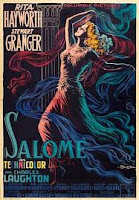 Now take the five letters you removed,
and place the last three before the first two. You will spell a five-letter
word that means “in motion.”
Now take the five letters you removed,
and place the last three before the first two. You will spell a five-letter
word that means “in motion.”
Who are these entertainers, and what two
words are formed that mean “in motion”?
Hint: One of the entertainers is
definitely known for being “in motion” when performing in concert.
Appetizer Menu
Captious Appetizer:
Nonhuman
Homophonia
Write a two-word caption for each of the
twelve images pictured here.

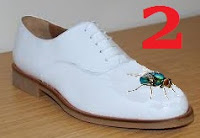 The second word in each caption will
name a kind of critter. The first word in each caption is a homophone.
The second word in each caption will
name a kind of critter. The first word in each caption is a homophone.
MENU
Ripping Off ron On Blaine’s Blog Slices:
“Ta” plus “bus” e(quals) plural “bus” unum
 Longtime Puzzlerian!
ron’s recent post on Blaine’s Blog (Wednesday, March 29, 09:55:00 PM PDT)
included the following puzzle that he created:
Longtime Puzzlerian!
ron’s recent post on Blaine’s Blog (Wednesday, March 29, 09:55:00 PM PDT)
included the following puzzle that he created:
The meaning of a common English word becomes plural when an A is added at its start.
What is the word?
Puzzleria’s Ripping
Off ron On Blaine’s Blog Slices read:
1. A common English singular noun becomes a
plural noun when a “g” is added to its beginning. What are these words?
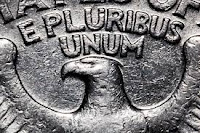 2. A common English singular noun becomes a
plural noun when a “ti” is added to its beginning. What are these words?
2. A common English singular noun becomes a
plural noun when a “ti” is added to its beginning. What are these words?
3. A common English singular noun becomes a
plural noun when a “si” is added to its beginning. What are these words?
4. A common English singular noun becomes a
plural noun when a “t” is added to its beginning. What are these words?
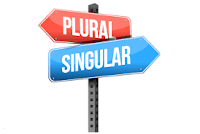 5. A common English singular noun becomes a
plural noun when an “o” is subtracted from its beginning. What are these words?
5. A common English singular noun becomes a
plural noun when an “o” is subtracted from its beginning. What are these words?
6. A common English singular noun becomes a
plural noun when an “n” is subtracted from its beginning. What are these words?
7. A common English singular noun becomes a
plural noun when an “s” is subtracted from its beginning. What are these words?
9. A somewhat common English singular noun becomes a plural noun when a “pu” is subtracted from its beginning. What are these words?
Ripping Off Shortz And Shteyman Slices:
Name two things found in a kitchen — one
starting with G, the other starting with K. If you have the right ones, you can
rearrange the letters to name two other things, one of them found in the
kitchen starting with F, the other one probably found elsewhere in the house
starting with K. What things are these?
Puzzleria’s
Riffing/Ripping Off Shortz Slices read:
ONE:
Name two things found in a kitchen — one
starting with T, the other starting with K.
If you have the right ones, you can rearrange the letters to name two other things, one of them found in the kitchen starting with T, the other one probably found in the closet (in a proverbial sense), starting with S. What things are these?
If you have the right ones, you can rearrange the letters to name two other things, one of them found in the kitchen starting with T, the other one probably found in the closet (in a proverbial sense), starting with S. What things are these?
TWO:
Name two things that might be found in a
kitchen — a type of sweet treat starting with S that might be served on
something starting with P.
If you have the right ones, you can rearrange the letters to name two other things found in the kitchen – complementary implements used in food preparation starting with P and M.
If you have the right ones, you can rearrange the letters to name two other things found in the kitchen – complementary implements used in food preparation starting with P and M.
What things are these?
THREE:
Name five things found in a kitchen:
two words starting with an M and a C
that you might see on a spice rack;
a small pastry, starting with T;
a “redible” root, starting with B; and
a wine that might be the choice of
liberals, starting with P.
If you have the right ones, you can rearrange these 22 letters to name three other things found in the kitchen:
If you have the right ones, you can rearrange these 22 letters to name three other things found in the kitchen:
a two-word term for items one wears, starting
with O and M;
a viscous mixture that food is dipped
into, starting with B.
What things are these?
Hint #1: Three of the four words comprising
the three other things found in the kitchen can also be found in a battery.
Hint #2: The M-word on the spice rack has a connection with this week's Dessert.
The C-word on the spice rack is a plural word.
The C-word on the spice rack is a plural word.
Dessert Menu
Olive branches soreheads?


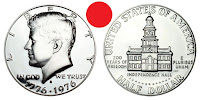 Displayed here are the obverse and
reverse sides of a purseful of coins, mostly quarters from the United States.
Displayed here are the obverse and
reverse sides of a purseful of coins, mostly quarters from the United States. 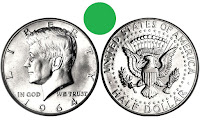
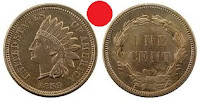 We have, however, also included a
Canadian one-cent piece, a French 20-franc piece, a Bahamian a 10-dollar piece,
an Albanian 5-frangia piece, an Italian 100-lire piece, an Isle of Man silver
proof bullion coin, and a South African krugerrand,
We have, however, also included a
Canadian one-cent piece, a French 20-franc piece, a Bahamian a 10-dollar piece,
an Albanian 5-frangia piece, an Italian 100-lire piece, an Isle of Man silver
proof bullion coin, and a South African krugerrand,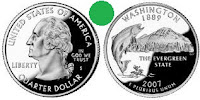 All green-circled
coins share something in common that the red-circled coins do not share. In
other words, there is something all of the green-circled coins have that the
red-circled coins lack.
All green-circled
coins share something in common that the red-circled coins do not share. In
other words, there is something all of the green-circled coins have that the
red-circled coins lack.
What do the red-circled coins lack that the green-circled coins do not lack?
Every Friday at Joseph Young’s
Puzzleria! we publish a new menu of fresh word puzzles, number puzzles, logic
puzzles, puzzles of all varieties and flavors. We cater to cravers of
scrumptious puzzles!
 Our master chef, Grecian gourmet puzzle-creator
Lego Lambda, blends and bakes up mysterious (and sometimes questionable)
toppings and spices (such as alphabet soup, Mobius bacon strips, diced snake
eyes, cubed radishes, “hominym” grits, anagraham crackers, rhyme thyme and sage
sprinklings.)
Our master chef, Grecian gourmet puzzle-creator
Lego Lambda, blends and bakes up mysterious (and sometimes questionable)
toppings and spices (such as alphabet soup, Mobius bacon strips, diced snake
eyes, cubed radishes, “hominym” grits, anagraham crackers, rhyme thyme and sage
sprinklings.)
Please post your comments below. Feel
free also to post clever and subtle hints that do not give the puzzle answers
away. Please wait until after 3 p.m. Eastern Time on Wednesdays to post your
answers and explain your hints about the puzzles. We serve up at least one
fresh puzzle every Friday.
We invite you to make it a habit to “Meet
at Joe’s!” If you enjoy our weekly puzzle party, please tell your friends about
Joseph Young’s Puzzleria! Thank you.




































